5.23 Maytas ESFA Release Notes
Note regarding submissions
We would like to remind providers to create a submission early and check for any errors using reports from the appropriate software (i.e. the FIS or LLWR-Inform). Welsh providers should also remember to download their ULI file. After submission to the ESFA or DfES, providers should check that data has submitted correctly using the available reports. Providers should check that all their expected starts and completions are submitted correctly, and that start and outcome payments correctly match the PFR or ACE funding reports.
Our support desk gets extremely busy in the days prior to the submission deadlines, and although we try and prioritise submission-related queries, we cannot guarantee assistance if queries are sent late. If you do encounter any issues, please ensure that you contact Maytas Support as soon as possible, as we can only rectify issues of which we are aware. We also recommend checking Maytas Communities regularly for information on any known issues and solutions. Tribal cannot be held responsible for any issues caused by your failure to comply with this advice.
Technical specification
The latest Maytas and Maytas Hub technical specification can be found here.
Once the upgrade has been completed, the version number should be checked to ensure it has been successful.
- Start Maytas and go to Support on the toolbar.
- Click About.
- The version numbers should read 5.23.8000.3. If you have any other version, please ensure you have followed the upgrade instructions correctly. If you require assistance, please contact Maytas Support.
It is the responsibility of customers to ensure that users carry out any required user acceptance testing and sign off on the upgrade.
Complete the Upgrade
Features Added in the Upgrade
These are the main updates in the upgrade:
- FE Workforce data collection and export
- DfE integration
- Permissions search
- Fixes to a number of issues
Reports Library 1.0.4.1 is also included in the upgrade but must be installed separately, which is detailed in the Upgrade Guide. The reports library can be downloaded here. If you are a hosted customer, please contact the Service Desk to arrange for the reports library update to be applied.
Import Funding Information
The process for importing the required funding information into Maytas is as follows:
- The LARS for 2021/22 should be imported.
- Postcode data for 2021/22 should be imported.
- Once all data has been imported, ensure that the funding cache is refreshed (either on a database schedule or a manual update out of working hours).
Import LARS
The LARS should be imported as follows:
- Download the latest LARS MDB file. At the time of this release, the latest version is the LARS MDB version 8.
- In Maytas, go to Exports on the toolbar.
- On the ILR Tools panel of the ribbon, go to Uploads | Upload Funding Information | Upload LARS (Version 8).
- Browse to and select the downloaded LARS file and click Open.
- The file will now be imported. Click OK on the message which appears.
Progress on the import can be checked by going to Home | Server Tasks | Server Jobs. Typically it will take several minutes.
Import Postcode File
- Obtain the postcode uplift factors file - Download the zip file under 2021 to 2022 uplift factors by postcode and LLSOA: CSV files.
- In Maytas, go to Exports on the toolbar.
- On the ILR Tools panel of the ribbon, go to Uploads | Upload Postcodes| Upload Post Code Data (2021/22).
- Browse to and select the postcode uplifts zip file and click Open.
- The file will now be imported. Click OK on the message which appears.
Progress on the import can be checked by going to Home | Server Tasks | Server Jobs. Typically this will take several minutes.
Note on the Funding Cache
By default, the funding cache will update overnight so that funding information in Maytas uses the newly-imported FIS and postcode information. Please check with your system administrator if you are unsure if or when the funding cache is updated on your system. You can also manually set the funding cache to update by going to Management | Profiles and clicking the Funding Cache button, though please be aware that this may take a long time and may use a large amount of system resources, which could affect performance for other users on the system.
Maytas 5 Version 5.23.8000.3 Release Notes
Maytas Support and Self Service
Maytas Support will soon be changing so that the available ways of contacting our support team are by telephone and by the Self Service portal, which allows you to raise tickets and track existing requests. Emailing the service desk directly will not be supported as a method for raising Maytas Incidents or Service requests from March 2022.
Incidents and Service Requests can be raised on the Self Service portal, which can accessed at:
The central Service Desk can be called on +44 1143080080. This is only recommended for P1 incidents or if you are unable to access the Self Service portal.
A guide to these changes can be found here.
FE Workforce Data Collection and Export
FE Workforce data can now be entered against personnel in Maytas and exported to an XML file for submission to the ESFA.
The FE Workforce features are a chargeable module which requires a new licence to be installed. Please contact your account manager for information on purchasing the module. If you manage your own on-premise installation of Maytas and have purchased the module, please ensure the licence is installed as per the instructions in the Maytas Upgrade Guide.
Workforce Permissions
Permissions must be set to enable Workforce features for a user:
- Go to Tools | Edit Permissions.
- Select the user or group which requires permission.
- On the Modules tab, set FE Workforce Data Collection to Visible
- Go to the Commands tab and expand the FEW Collection section.
- There are permissions for deleting, generating, outputting, saving, validating and viewing FEW data. Set each permission to Visible as required.
- Click Apply and restart Maytas for the changes to take effect.
Data Entry
To enter Workforce data against a personnel record:
- Search for and open the personnel record in Maytas.
-
Go to the Workforce Data tab.
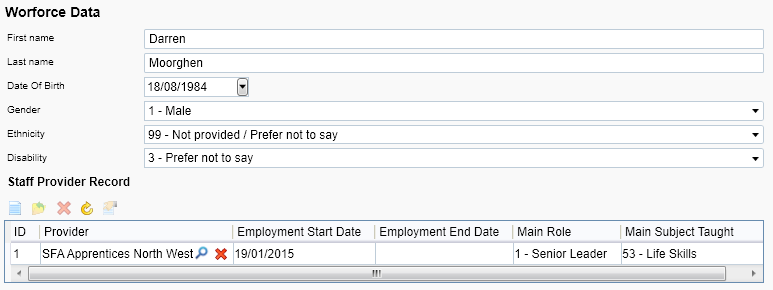
-
Complete the data as required, then click the
 button on the grid to add a new staff provider record.
button on the grid to add a new staff provider record.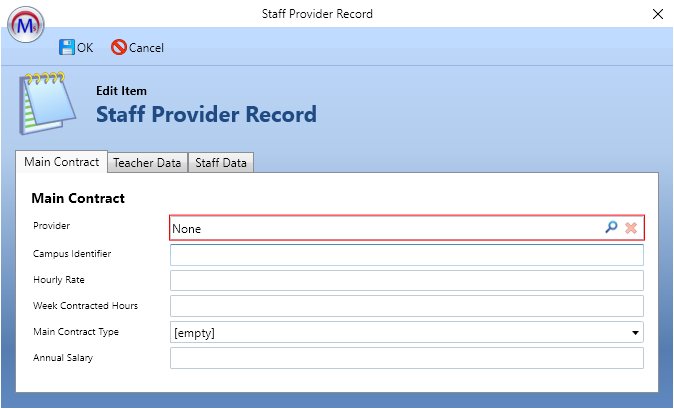
-
Complete the Main Contract, Teacher Data and Staff Data tabs as required.
For the Provider field, click the
 button at the end of the row to search for and select one of the available entries, which come from the Contractor table.
button at the end of the row to search for and select one of the available entries, which come from the Contractor table. - Click OK when finished.
- Click Apply to save changes.
Workforce Export
To export Workforce data:
-
Go to Exports | FEW Export.

-
Click the
 button to generate a new export.
button to generate a new export.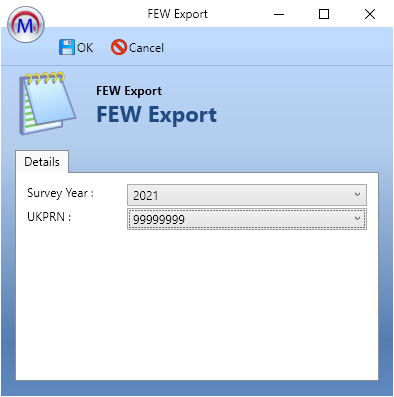
-
Select the Survey Year and UKPRN to generate the export for.
The available UKPRN values are taken from the CONTRACTOR.UKPRN20 field, as the FEW export is currently limited to the 2020/21 format. This will be updated to use UKPRN21 when the FEW 2021/22 format is released.
- Click OK.
- A new row will be added to the grid. When the export has finished, the status will display Generated.
- To validate the export, select it in the grid and click the
 button on the grid tools. Validation errors will be displayed in the lower half of the screen.
button on the grid tools. Validation errors will be displayed in the lower half of the screen. - To output the export to an XML file, click the
 button on the grid tools. The file will be sent to the same folder where ILR exports are output to, which is determined by the configuration option at Maytas 5 | ILR Export | The output directory for ILR export files. If the configuration option is not present, files are sent to C:\temp.
button on the grid tools. The file will be sent to the same folder where ILR exports are output to, which is determined by the configuration option at Maytas 5 | ILR Export | The output directory for ILR export files. If the configuration option is not present, files are sent to C:\temp. - Once the XML file has been output, you can choose to save a copy at a location of your choice by clicking the
 button on the grid tools.
button on the grid tools. - Additionally, you can use the
 button to regenerate an export and the
button to regenerate an export and the  button to delete an export (note that this deletes the export from the database - it does not delete any saved XML outputs of the export).
button to delete an export (note that this deletes the export from the database - it does not delete any saved XML outputs of the export).
Scheduler
The Scheduler is a centralised tool for setting up and viewing all things that can be scheduled in Maytas. This includes the features from the Report Scheduler introduced in the 5.21 upgrade, but also allows you to manage schedules for the funding cache.
To enable the Scheduler for a user:
- Go to Tools | Edit Permissions.
- Select the user or group which requires permission.
- Go to the Commands tab and expand the Scheduler section.
- Set the permission Show Scheduler to Visible.
- Click Apply.
- Restart Maytas for the permission to take effect.
To access the Scheduler, go to Tools | Scheduler.
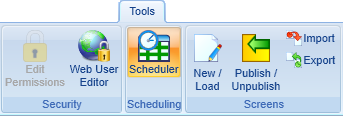
The Scheduler will open.
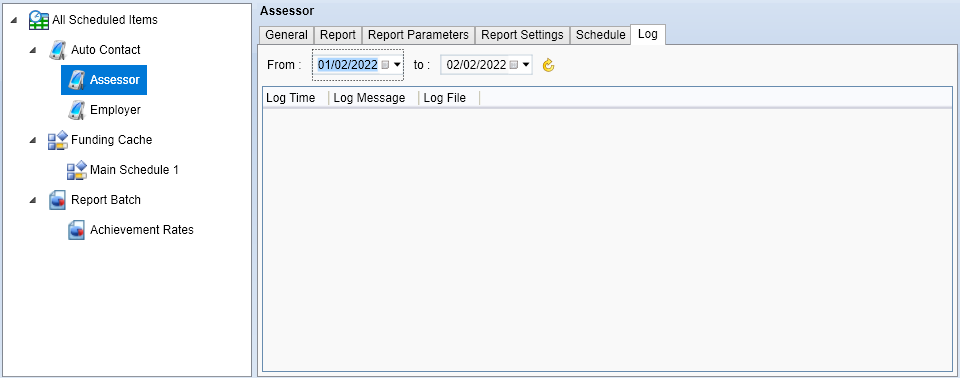
The tree view on the left lists all scheduled items, split by auto-contact reports, funding cache schedules and report batches.
Create a Funding Cache Schedule
- Go to Actions on the toolbar and select New | Funding Cache.
- On the General tab, enter a name and description for the schedule.
-
Choose the years to run the funding cache for. If you wish to include a refresh of the QAR cache as well, tick the Ofsted Data box.
For FM36 funding, funding cache information from previous years is used in the calculations. However, if data has not changed for a previous year since the last funding cache update, that year does not need to be included in the cache update each time as it will remain unchanged. As such (and taking into account that the more years that are included, the longer the cache update will take), it is recommended to only include previously cached years when data is likely to change for them (e.g. the previous year) or if you know of specific data that has changed for a past year.
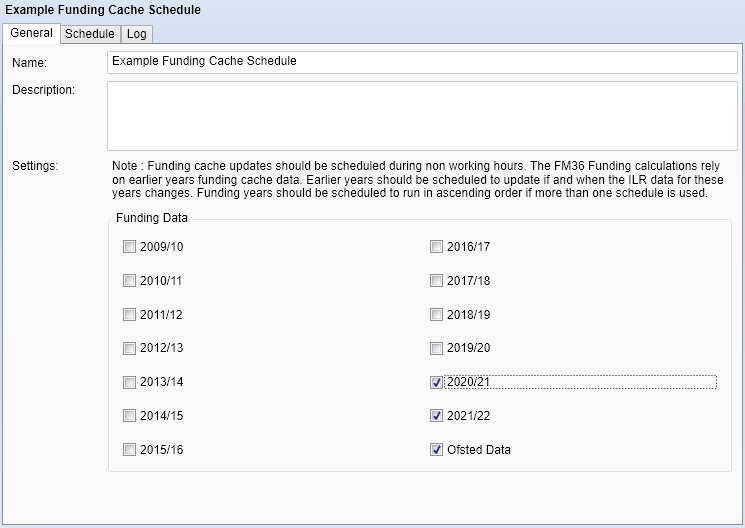
-
Go to the Schedule tab. This is where you can configure when (and how often) the funding cache will run.
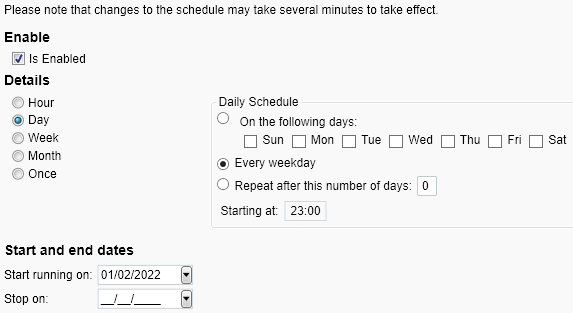
-
Set the schedule in the Details section. It can be set to run periodically (e.g. every day, week, etc) or just once at a specified time. Please note that if you intend to start the schedule immediately, the start time should be at least 10 minutes in the future to ensure it is picked up by the system.
It is strongly recommended to schedule the funding cache to run out of business hours, as it can take a long time to complete depending on the size of the database and various other factors and may use a large amount of system resources during that time.
- Set the start date at the bottom of the window. The schedule will run indefinitely by default, but if you want the schedule to end on a particular date then tick the Stop this schedule on box and set the date.
- When you have finished configuring the schedule and want to activate the schedule, tick the Is Enabled box at the top of the tab.
- Click Apply on the ribbon to save the schedule.
The Log tab shows a log of when the schedule has been run, which can be filtered between two dates.
Create an Auto Contact Schedule
Auto Contact schedules require a mail merge report to be configured for auto-communication. Details of this can be found here.
- Go to Actions on the toolbar and select New | Auto Contact.
- On the General tab, enter a name for the schedule. Leave the subject and message for now.
- Go to the Report tab and select Maytas on the left.
-
Select the report you wish to use on the right. Note that only reports configured for auto-communication will appear here.
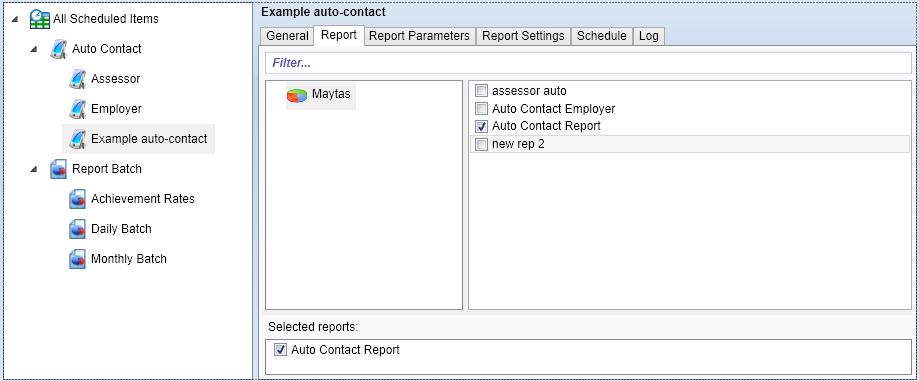
- Go back to the General tab and amend the subject and message as required (they will default to the values entered when configuring auto-communication).
-
Go to the Report Parameters tab and click the arrow next to the chosen report to expand its parameters.
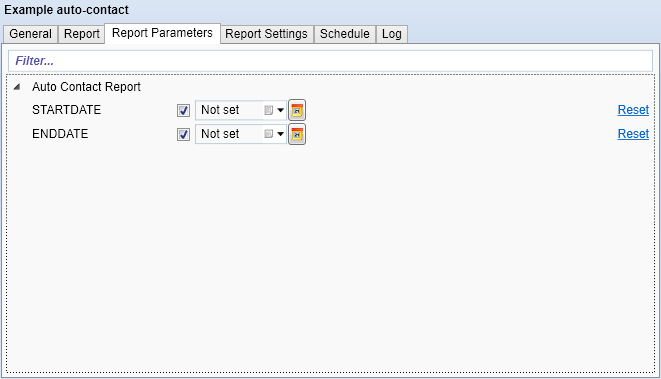
In this example, the report filters learners based on their POT start date being between the STARTDATE and ENDDATE parameters.
- Configure the parameters as required.
-
Go to the Schedule tab.
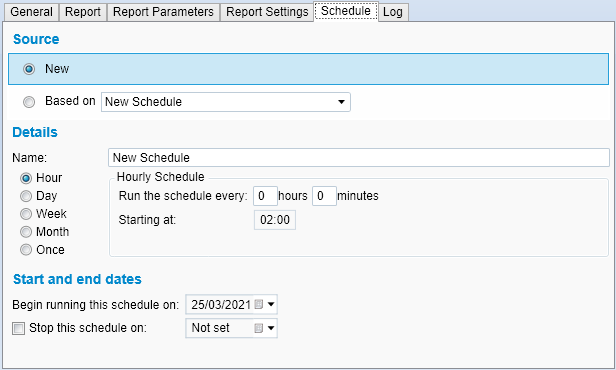
- On this screen, the schedule can be configured. If you have an existing schedule, you can choose it by clicking Based on and selecting it from the list. Otherwise select New.
- Set the schedule in the Details section. It can be set to run periodically (e.g. every hour, day, month, etc) or just once at a specified time. Please note that if you intend to start the schedule immediately, the start time should be at least 10 minutes in the future to ensure it is picked up by the system.
- Set the start date at the bottom of the window. The schedule will run indefinitely by default, but if you want the schedule to end on a particular date then tick the Stop this schedule on box and set the date.
- Click Apply on the ribbon to save the schedule.
The Log tab shows a log of when the schedule has been run, which can be filtered between two dates.
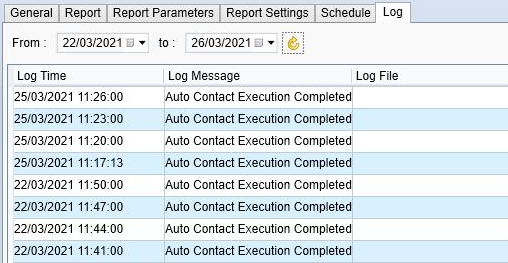
The Report Settings tab shows key information about how the report auto-communication is configured. Note that this tab is read-only.
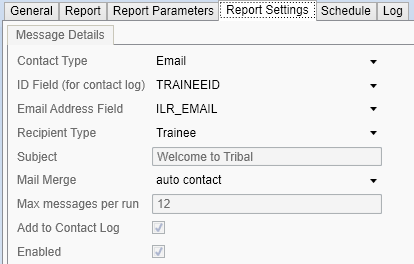
Create a Report Batch Schedule
- Go to Actions on the toolbar and select New | Report Batch.
-
On the General tab, enter a name for the batch and enter your recipient email addresses in the email recipients box at the bottom.
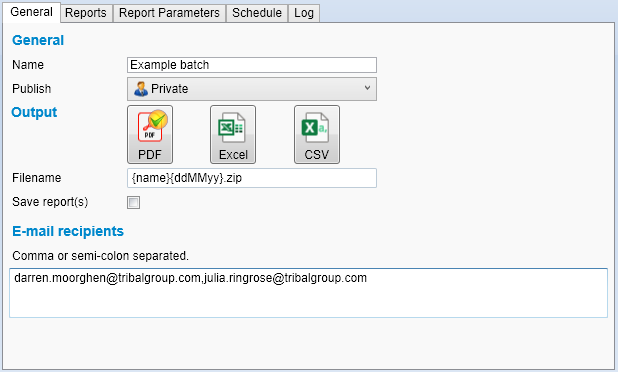
There are also options to publish privately, globally or to a group, to export to PDF, CSV or Excel and to alter the filename, but for this example we will accept the defaults. Note that the default filename of {name}{ddMMyy}.zip will create a file using the batch name and the date it was created.
-
Go to the Reports tab, where you can choose which reports to include in the batch. Click the arrow next to Maytas or Reporting Services to shows reports created in Report Generator or reports from the Reports Library respectively. The select reports will be shown at the bottom of the screen.
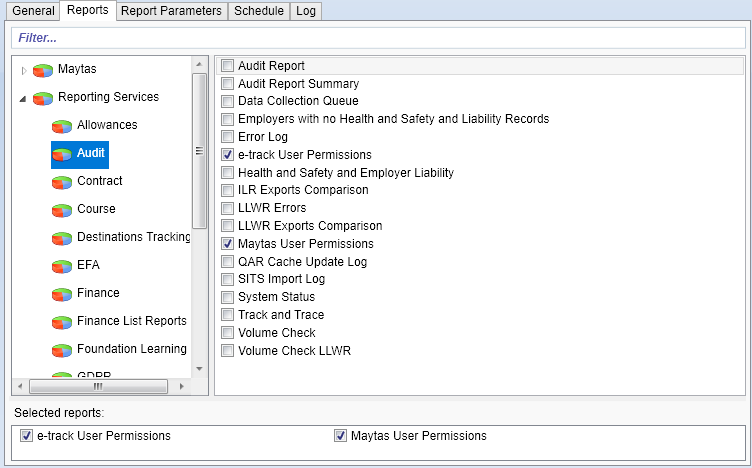
-
Go to the Report Parameters screen and click the arrow next to each report to expand its parameters. Configure the parameters as required.
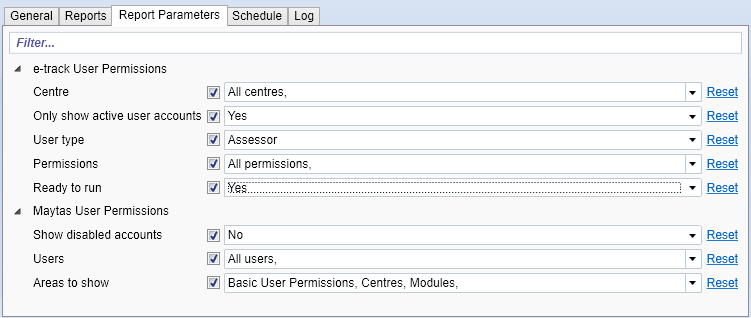
-
Go to the Schedule tab.
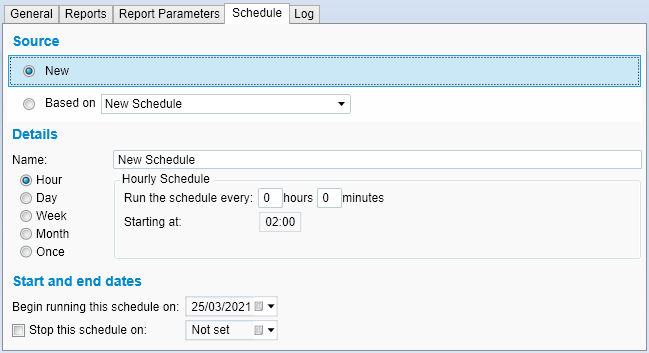
- On this screen, the schedule can be configured. If you have an existing schedule, you can choose it by clicking Based on and selecting it from the list. Otherwise select New.
- Set the schedule in the Details section. It can be set to run periodically (e.g. every hour, day, month, etc) or just once at a specified time. Please note that if you intend to start the schedule immediately, the start time should be at least 10 minutes in the future to ensure it is picked up by the system.
- Set the start date at the bottom of the window. The schedule will run indefinitely by default, but if you want the schedule to end on a particular date then tick the Stop this schedule on box and set the date.
- Click Apply on the ribbon to save the schedule.
The Log tab shows a log of when the schedule has been run, which can be filtered between two dates.
Report Scheduling Configuration Options
There are several configuration options which can be set for report scheduling:
- Click the M5 button at the top-left and select Options.
- Select Admin on the left (under the Maytas 5 header).
-
Scroll down to the Reporting section on the right. There are three applicable options:
- Scheduling Verbose Logging - Off by default. When this is enabled, the logs for report batches will include additional information. After enabling it, Maytas must be closed and the data service must be stopped and restarted in Maytas Server Manager (please contact Tribal if your Maytas server is managed by us).
- Include email messages in scheduling logs - Enabled by default. This will include the contents of email messages in the log entries.
- Remove mail attachments from scheduling log entries - Enabled by default. This will remove mail attachments when saving email content in log entries.
- An additional option, Scheduling Verbose Logging, can be found by selecting Auto Contact on the left (under the Maytas 5 header). This is off by default. When it is enabled, the logs for auto-contact schedules will include additional information. After enabling it, Maytas must be closed and the data service must be stopped and restarted in Maytas Server Manager (please contact Tribal if your Maytas server is managed by us).
- Click OK when finished.
DfE Integration
Maytas now integrates with the DfE API so that Maytas learner records can be generated from DfE participant records, allowing DfE courses to be managed and declarations to be uploaded from Maytas..
A new licence is required for the DfE integration - please contact your account manager for more information.
Setup
Configuration options must be set before using the integration:
- In Maytas, click the M5 button at the top left and select Options.
- Go to Other on the left (under the Maytas 5 header).
-
In the DFE section, tick the boxes for each config option and enter the values as follows:
- Centre - Enter the centre ID for the centre you wish to use for learners imported from the DfE.
- Contractor - Enter the contractor ID for the contractor you wish to use for learners imported from the DfE.
-
API Token - This can be obtained from the DfE by emailing them at:
continuing-professional-development@digital.education.gov.uk
-
Url for API - For a TEST system, this should be:
https://ecf-sandbox.london.cloudapps.digital/api/v1
For a LIVE system, this should be:
https://manage-training-for-early-career-teachers.education.gov.uk/api/v1
- Click OK.
Next, permissions must be set to access the system:
- Go to Tools | Edit Permissions.
- Select the user or group which requires permission.
- On the Modules tab, set the DFE Integration permission to Visible.
- Go to the Commands tab and expand the DFE section.
- Set each permission to Visible as required.
- Click Apply to save changes, then restart Maytas for the permission to take effect.
Finally, the DfE tabs must be made available:
- Go to Tools on the toolbar and click New / Load on the Screens panel of the ribbon.
- Scroll down and select Trainee on the left.
- Select DfE Data on the right and click OK.
- Tick the Published box on the left.
- Click Apply on the ribbon.
- Repeat the above steps for the DfE Declarations tab (also in the Trainee section).
- Go to Home on the toolbar and click the Sync button.
Downloading all participants from the DfE
To download all participants from the DfE so that learner records are generated for them in Maytas:
- In Maytas, go to Management on the toolbar.
- On the Third Party panel of the ribbon, go to DFE | Get All Participants.
-
Available ECF participants and NPQ applicants will now be downloaded.
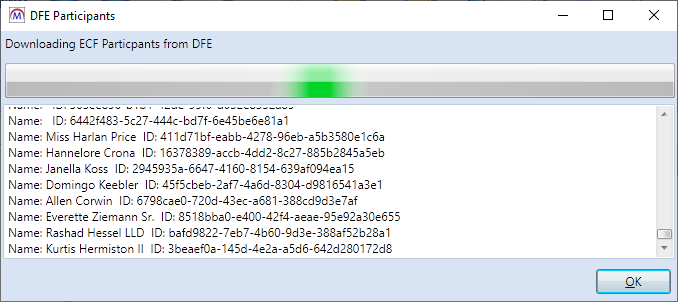
This may take a long time depending on the number of available records. Clicking OK will continue the download in the background, and progress can be checked by going to DFE | Get All Participants again.
- When the download has finished, the text No more NPQ Applicant updates found will appear at the bottom of the log. Click OK.
-
Learner records will now be available in Maytas for each downloaded participant / applicant. The imported data can be viewed on the DfE Data tab on learner records, which also includes basic Maytas learner fields that can be completed.
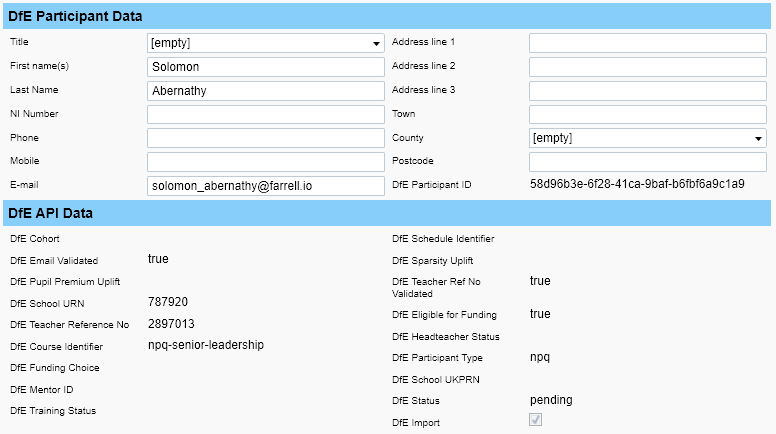
Downloading updates from the DfE
Rather than downloading all participants from the DfE each time, you can instead only download records which have been added or updated since the last download. To do this:
- In Maytas, go to Management on the toolbar.
- On the Third Party panel of the ribbon, go to DFE | Get Updates.
- Any added or updated records will now be downloaded.
- Click OK when the updates have finished downloading.
Searching for learners imported from the DfE
A search option can be added to Maytas to filter by learners who have been imported from the DfE. Another search option can also be added to filter by NPQ or ECF participants:
- Go to Tools on the toolbar and click Fields on the Search panel of the ribbon.
- Select Trainee on the left.
- Click the Add button on the right.
-
In the new row which appears, select TRAINEEPOT2 in the left dropdown box and DFE_IMPORT in the right dropdown box. Imported DfE participants will have a value of Y in this field.
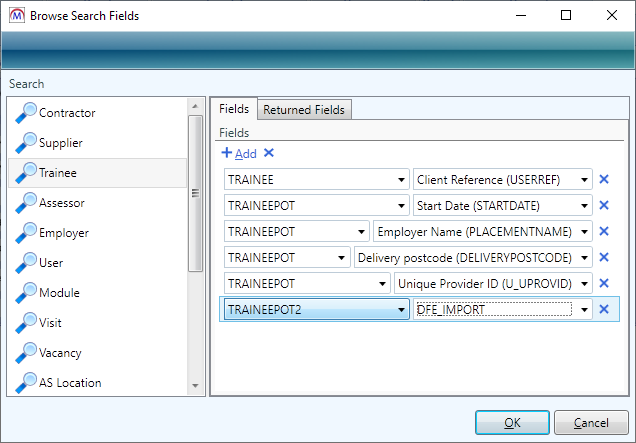
- Add another row and select TRAINEEPOT2 in the left dropdown box and DFE_PARTICIPANT_TYPE in the right dropdown box. NPQ participants will have a value of npq, whereas ECF participants will have a value of ect or mentor.
- Click OK.
-
Go to Home on the toolbar and expand the Advanced section under the search box.
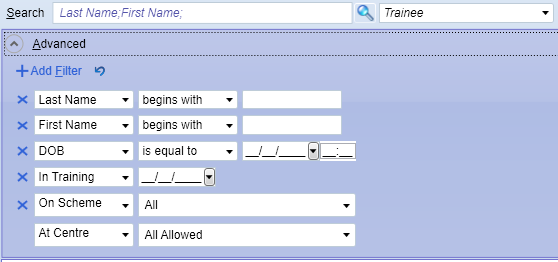
- Click Add Filter.
-
In the new row that appears, select DFE_IMPORT, then set the other boxes to is equal to and Y. This will filter by learners imported from the DfE.
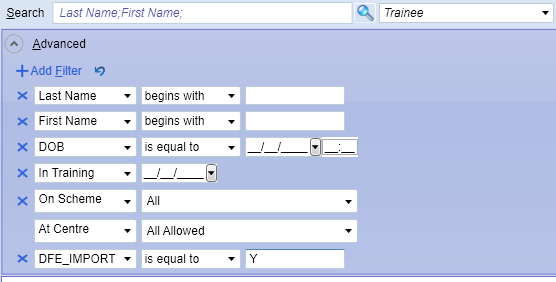
-
Add another row and set it to DFE_PARTICIPANT_TYPE. Set the middle dropdown box to is equal to. You can then use the right-hand text box to enter the type of learner you want to search by (npq, ect or mentor).

Adding and uploading declarations
Declarations can be added to a learner in Maytas and then uploaded to their participant record in the DfE.
To add a declaration to a learner:
- On the learner's record, go to the DfE Declarations tab.
-
Click the
 button on the grid.
button on the grid.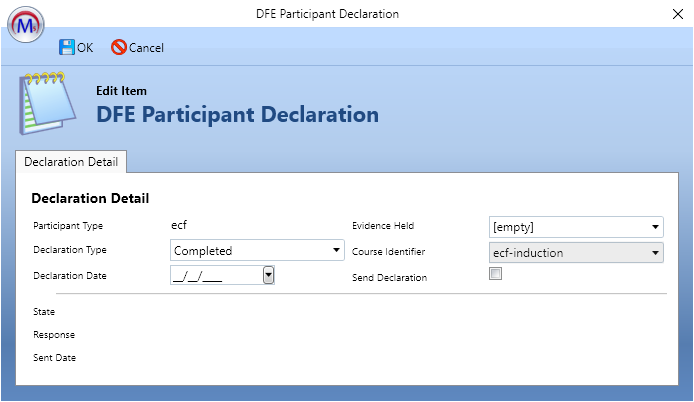
- Complete the declaration details as required. Only tick the Send Declaration box if the declaration is ready to be uploaded.
- Click OK.
- Click Apply. Additional declarations can be added as required.
To upload all declarations for the learner where the Send Declaration box is ticked:
- From the learner's record, go to Actions | DFE | Post Declarations.
-
Any declarations for the learner with Send Declaration ticked will now be uploaded. The result of each row will be displayed in the log, along with any errors.
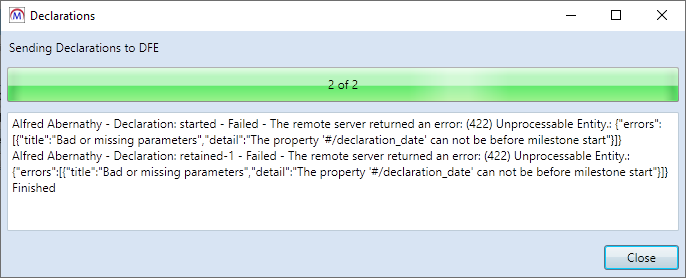
- Click Close when finished.
To bulk upload declarations for all learners:
-
Go to Management | DFE | Post Declarations. The Post Declarations window will appear.
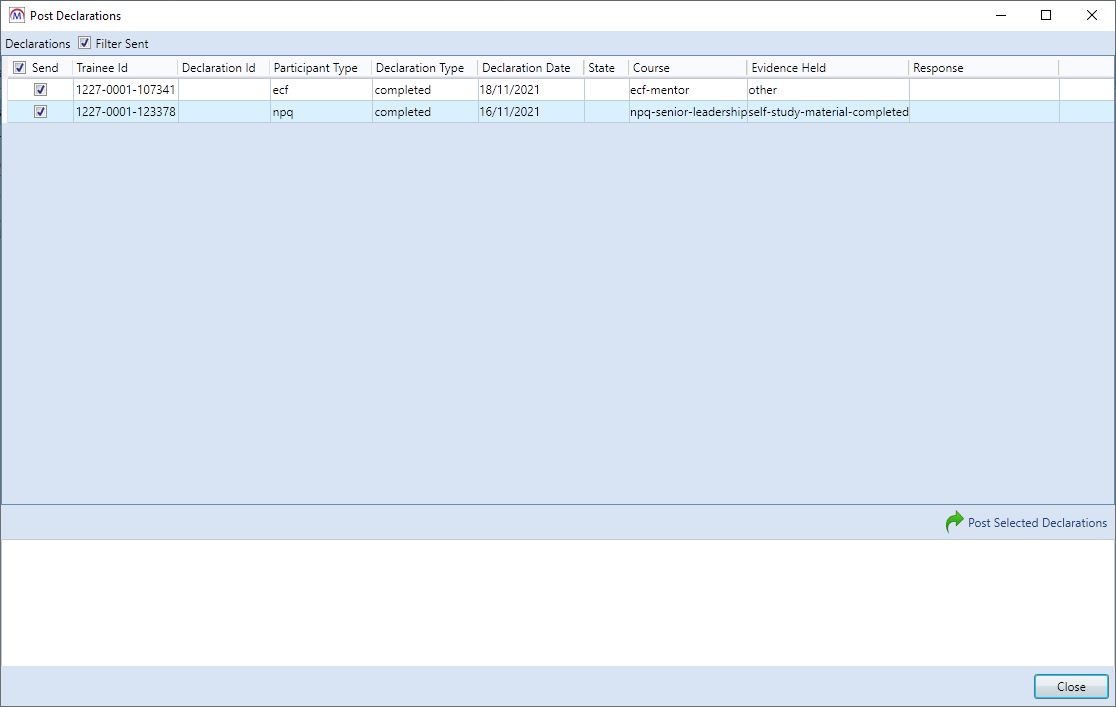
- The rows to be posted will be displayed at the top. To de-select a row so that it is not sent, un-tick the Send box.
- Click Post Selected Declarations (near the bottom right) to send the rows to the DfE.
- The status of each row will be shown in the log at the bottom of the window. Click Close when finished.
Voiding declarations
To void a learner's declarations:
-
In the learner's record, go to Actions | DFE | Void Declarations.
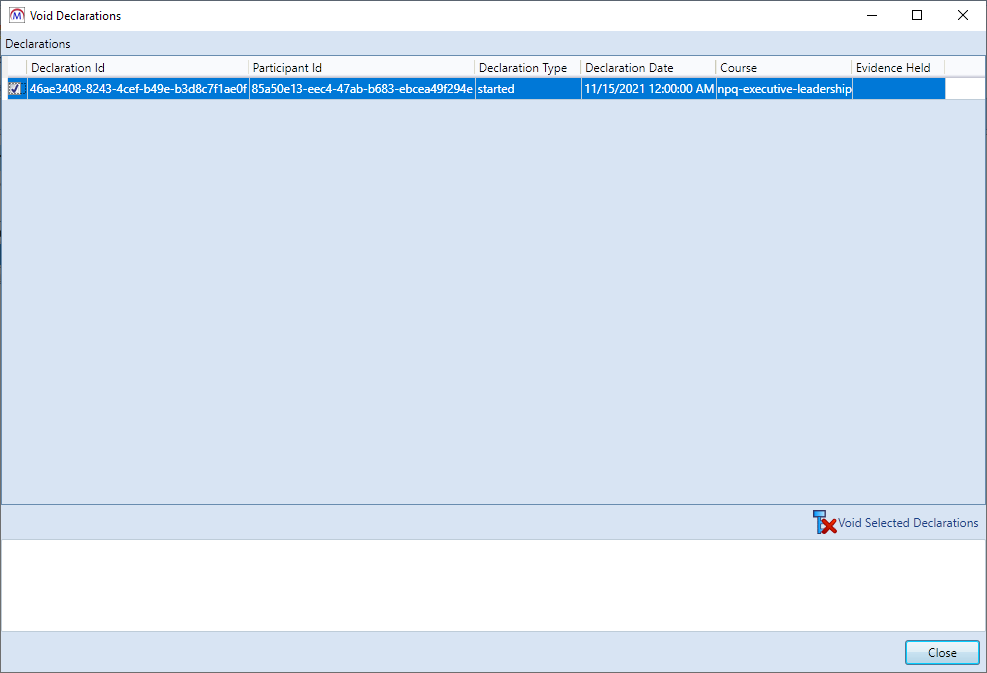
- Tick the checkbox on the left next to each declaration you wish to void.
- Click the Void Selected Declarations button near the bottom right.
- You will be asked to confirm. Click Yes to continue.
-
The selected declarations will now be processed and their status will be shown in the log at the bottom.

- Click Close when finished.
Managing courses
To manage a learner's course, from the learner's record, go to Actions | DFE | Manage Course.
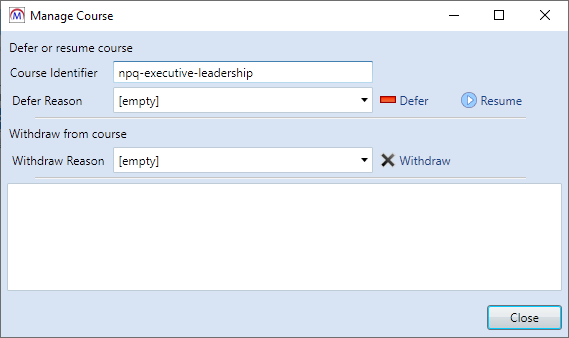
From here you can defer a course, resume a course or withdraw from a course.
To defer a course:
- Choose the Defer Reason from the dropdown list.
-
Click the Defer button.
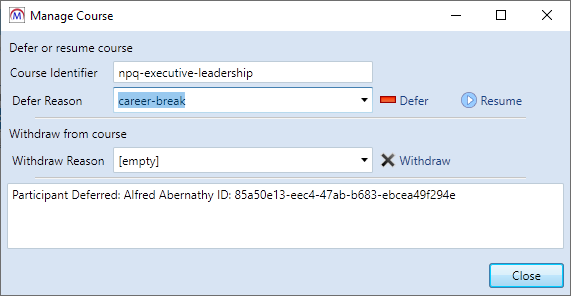
- The course will now be deferred, as indicated in the log at the bottom of the window. Click Close.
To resume a deferred course:
-
Click the Resume button.
- The course will now be resumed, as indicated in the log at the bottom of the window. Click Close.
To withdraw from a course:
- Choose the Withdraw Reason from the dropdown list.
- Click the Withdraw button.
-
You will be asked to confirm. Click Yes to continue.
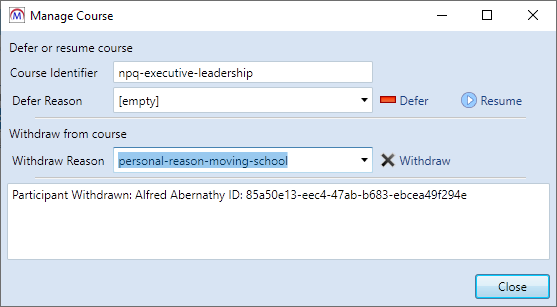
- The course will now be withdrawn, as indicated in the log at the bottom of the window. Click Close.
ECF participants have an additional option to change the course schedule:
-
Choose the schedule you wish to apply to the course from the Schedule Identifier dropdown box.
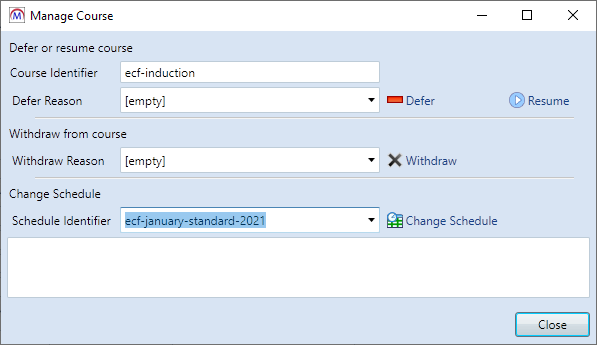
- Click the Change Schedule button. If the learner has existing declarations that would be invalidated by changing the schedule, this will be indicated in the log. It can be rectified by voiding the declarations.
- The selected schedule will now be applied to the course. Click Close.
Accepting or rejecting applications
This option is only available for NPQ applicants, not ECF participants.
To accept or reject an NPQ applicant for an individual learner:
-
In the learner's record, go to Actions | DFE | Accept/Reject Application.
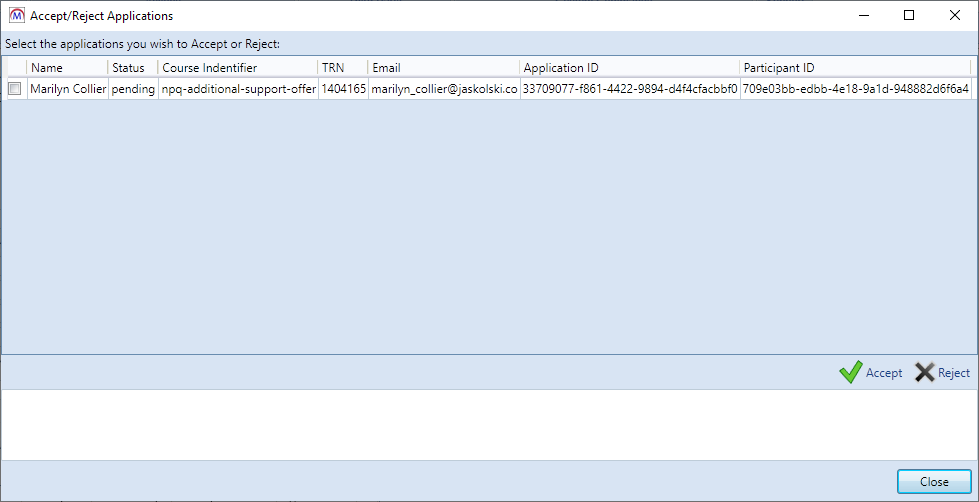
- Tick the checkbox on the left next to each row you wish to accept or reject.
- Click the Accept or Reject button near the bottom right.
- You will be asked to confirm. Click Yes to continue.
- The selected applications will now be processed and their status will be shown in the log at the bottom. Click Close when finished.
To accept or reject applications in bulk:
-
Go to Management | DFE | Accept/Reject NPQ Applications.
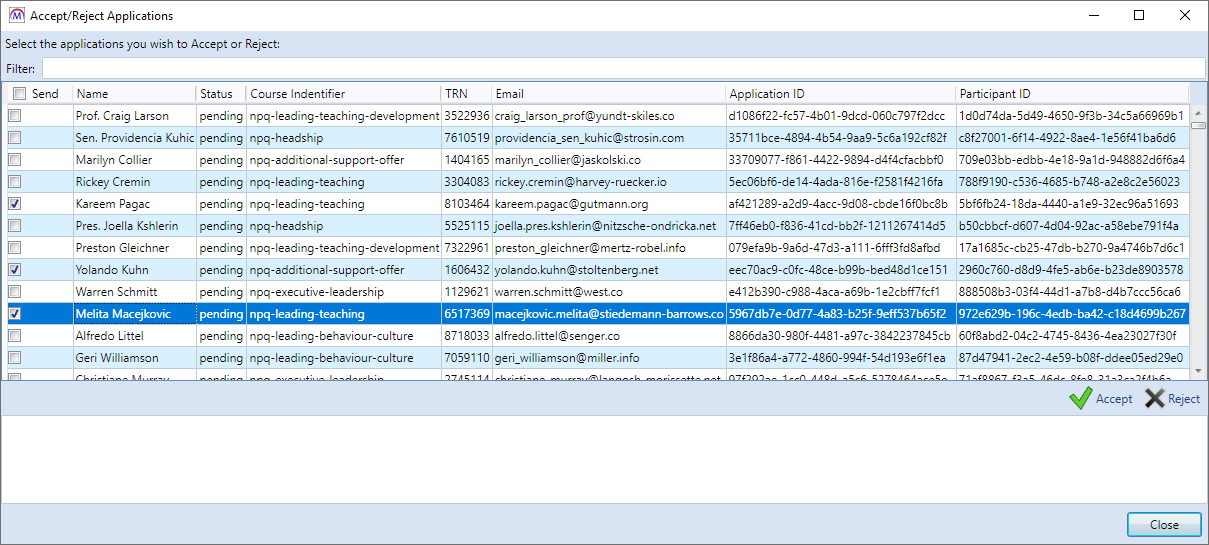
- Tick the checkbox on the left next to each row you wish to accept or reject. You can also tick the checkbox in the header (next to Send) to select all rows, or enter a value in the Filter box at the top to filter on rows containing that value.
- Click the Accept or Reject button near the bottom right.
- You will be asked to confirm. Click Yes to continue.
-
The selected applications will now be processed and their status will be shown in the log at the bottom.

- Click Close when finished.
Edit Permissions - Search for Permissions
The Edit Permissions screen now includes a search box to let you search for permissions on each tab.

Employer on Skill Scan Queue Tab
The Skill Scan Queue tab for learners now displays the relevant employer for each scan.

To import the updated tab:
- Go to Tools on the toolbar.
- On the Screens panel of the ribbon, click Import.
- Click Browse.
- Browse to the Maytas 5\Extras\Tabs folder of the upgrade, select Skill Scan Queue.m5tab and click Open.
- Click Next to import the tab.
- Click Finish.
- Go to Home on the toolbar and click the Sync button.
Reports Library 1.0.4.1
Assessor and Employment Type Overhaul
The reports library has been overhauled so that all reports that use a learner's assessor type or employment type now allow you to select the types to include via parameters.
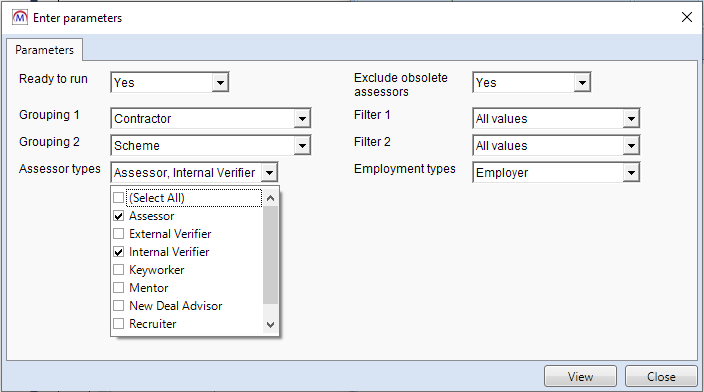
Configuration options are available to let you specify the values that are selected by default for the assessor and employment type parameters in each report. If left unchanged (or if the config options are removed), the default selections are:
- Assessor type - Assessor (short string A)
- Employment type - Employer (short string E)
These are the same types which the majority of reports previously used.
To alter these values:
- In Maytas, click the M5 button at the top left and select Options.
- Select Reports Library on the left (under the Maytas 5 header).
- Scroll down to the General section on the right.
- Ensure the checkbox is ticked for the following two config options:
- Default trainee-employer types to use in reports
- Default trainee-assessor types to use in reports
- For each config, enter the lookup short string values to be selected by default in reports, with each value comma-separated (e.g. A,B,C). The lookup fields are TRASSESSOR.ASSESSORTYPE for assessor types and TREMPLOYER.EMPLOYMENTTYPE for employment types.
- Click OK.
The configuration options only determine which types are selected by default when a report is run. If you wish to use different types when running a report, these can be selected in the report parameters.